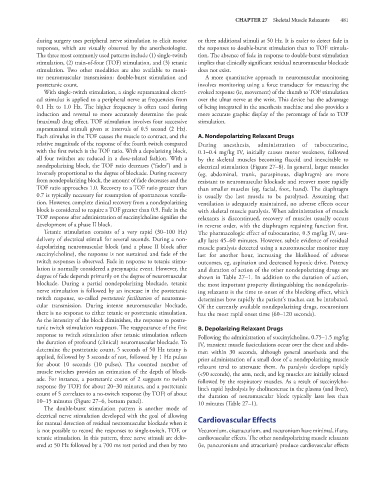Page 495 - Basic _ Clinical Pharmacology ( PDFDrive )
P. 495
CHAPTER 27 Skeletal Muscle Relaxants 481
during surgery uses peripheral nerve stimulation to elicit motor or three additional stimuli at 50 Hz. It is easier to detect fade in
responses, which are visually observed by the anesthesiologist. the responses to double-burst stimulation than to TOF stimula-
The three most commonly used patterns include (1) single-twitch tion. The absence of fade in response to double-burst stimulation
stimulation, (2) train-of-four (TOF) stimulation, and (3) tetanic implies that clinically significant residual neuromuscular blockade
stimulation. Two other modalities are also available to moni- does not exist.
tor neuromuscular transmission: double-burst stimulation and A more quantitative approach to neuromuscular monitoring
posttetanic count. involves monitoring using a force transducer for measuring the
With single-twitch stimulation, a single supramaximal electri- evoked response (ie, movement) of the thumb to TOF stimulation
cal stimulus is applied to a peripheral nerve at frequencies from over the ulnar nerve at the wrist. This device has the advantage
0.1 Hz to 1.0 Hz. The higher frequency is often used during of being integrated in the anesthesia machine and also provides a
induction and reversal to more accurately determine the peak more accurate graphic display of the percentage of fade to TOF
(maximal) drug effect. TOF stimulation involves four successive stimulation.
supramaximal stimuli given at intervals of 0.5 second (2 Hz).
Each stimulus in the TOF causes the muscle to contract, and the A. Nondepolarizing Relaxant Drugs
relative magnitude of the response of the fourth twitch compared During anesthesia, administration of tubocurarine,
with the first twitch is the TOF ratio. With a depolarizing block, 0.1–0.4 mg/kg IV, initially causes motor weakness, followed
all four twitches are reduced in a dose-related fashion. With a by the skeletal muscles becoming flaccid and inexcitable to
nondepolarizing block, the TOF ratio decreases (“fades”) and is electrical stimulation (Figure 27–8). In general, larger muscles
inversely proportional to the degree of blockade. During recovery (eg, abdominal, trunk, paraspinous, diaphragm) are more
from nondepolarizing block, the amount of fade decreases and the resistant to neuromuscular blockade and recover more rapidly
TOF ratio approaches 1.0. Recovery to a TOF ratio greater than than smaller muscles (eg, facial, foot, hand). The diaphragm
0.7 is typically necessary for resumption of spontaneous ventila- is usually the last muscle to be paralyzed. Assuming that
tion. However, complete clinical recovery from a nondepolarizing ventilation is adequately maintained, no adverse effects occur
block is considered to require a TOF greater than 0.9. Fade in the with skeletal muscle paralysis. When administration of muscle
TOF response after administration of succinylcholine signifies the relaxants is discontinued, recovery of muscles usually occurs
development of a phase II block. in reverse order, with the diaphragm regaining function first.
Tetanic stimulation consists of a very rapid (30–100 Hz) The pharmacologic effect of tubocurarine, 0.3 mg/kg IV, usu-
delivery of electrical stimuli for several seconds. During a non- ally lasts 45–60 minutes. However, subtle evidence of residual
depolarizing neuromuscular block (and a phase II block after muscle paralysis detected using a neuromuscular monitor may
succinylcholine), the response is not sustained and fade of the last for another hour, increasing the likelihood of adverse
twitch responses is observed. Fade in response to tetanic stimu- outcomes, eg, aspiration and decreased hypoxic drive. Potency
lation is normally considered a presynaptic event. However, the and duration of action of the other nondepolarizing drugs are
degree of fade depends primarily on the degree of neuromuscular shown in Table 27–1. In addition to the duration of action,
blockade. During a partial nondepolarizing blockade, tetanic the most important property distinguishing the nondepolariz-
nerve stimulation is followed by an increase in the posttetanic ing relaxants is the time to onset of the blocking effect, which
twitch response, so-called posttetanic facilitation of neuromus- determines how rapidly the patient’s trachea can be intubated.
cular transmission. During intense neuromuscular blockade, Of the currently available nondepolarizing drugs, rocuronium
there is no response to either tetanic or posttetanic stimulation. has the most rapid onset time (60–120 seconds).
As the intensity of the block diminishes, the response to postte-
tanic twitch stimulation reappears. The reappearance of the first B. Depolarizing Relaxant Drugs
response to twitch stimulation after tetanic stimulation reflects Following the administration of succinylcholine, 0.75–1.5 mg/kg
the duration of profound (clinical) neuromuscular blockade. To IV, transient muscle fasciculations occur over the chest and abdo-
determine the posttetanic count, 5 seconds of 50 Hz tetany is men within 30 seconds, although general anesthesia and the
applied, followed by 3 seconds of rest, followed by 1 Hz pulses prior administration of a small dose of a nondepolarizing muscle
for about 10 seconds (10 pulses). The counted number of relaxant tend to attenuate them. As paralysis develops rapidly
muscle twitches provides an estimation of the depth of block- (<90 seconds), the arm, neck, and leg muscles are initially relaxed
ade. For instance, a posttetanic count of 2 suggests no twitch followed by the respiratory muscles. As a result of succinylcho-
response (by TOF) for about 20–30 minutes, and a posttetanic line’s rapid hydrolysis by cholinesterase in the plasma (and liver),
count of 5 correlates to a no-twitch response (by TOF) of about the duration of neuromuscular block typically lasts less than
10–15 minutes (Figure 27–6, bottom panel). 10 minutes (Table 27–1).
The double-burst stimulation pattern is another mode of
electrical nerve stimulation developed with the goal of allowing Cardiovascular Effects
for manual detection of residual neuromuscular blockade when it
is not possible to record the responses to single-twitch, TOF, or Vecuronium, cisatracurium, and rocuronium have minimal, if any,
tetanic stimulation. In this pattern, three nerve stimuli are deliv- cardiovascular effects. The other nondepolarizing muscle relaxants
ered at 50 Hz followed by a 700 ms rest period and then by two (ie, pancuronium and atracurium) produce cardiovascular effects

